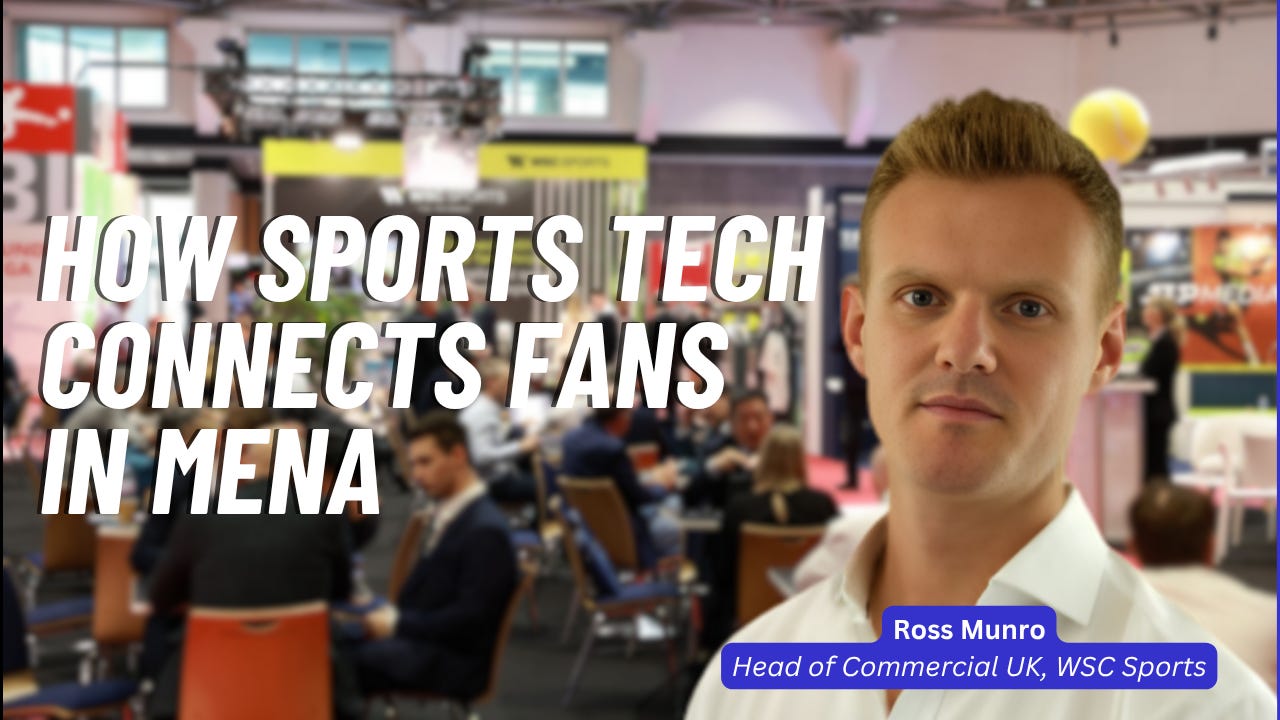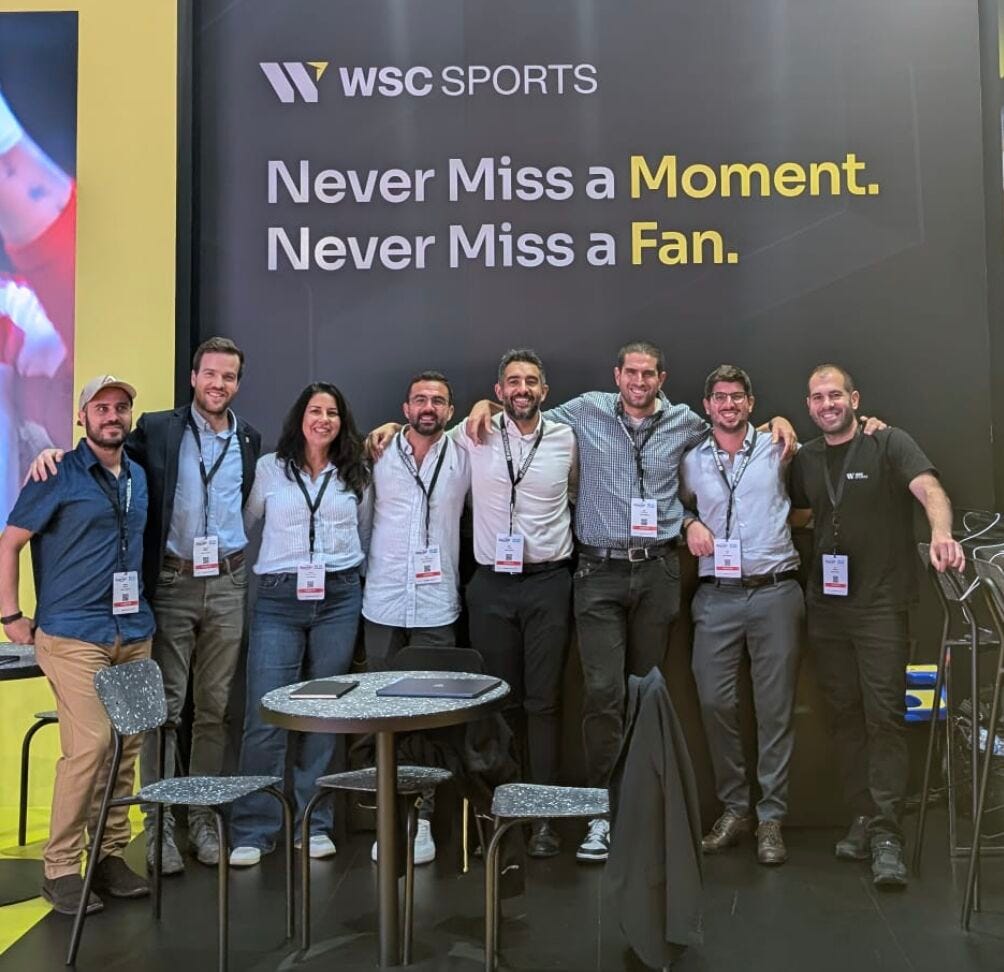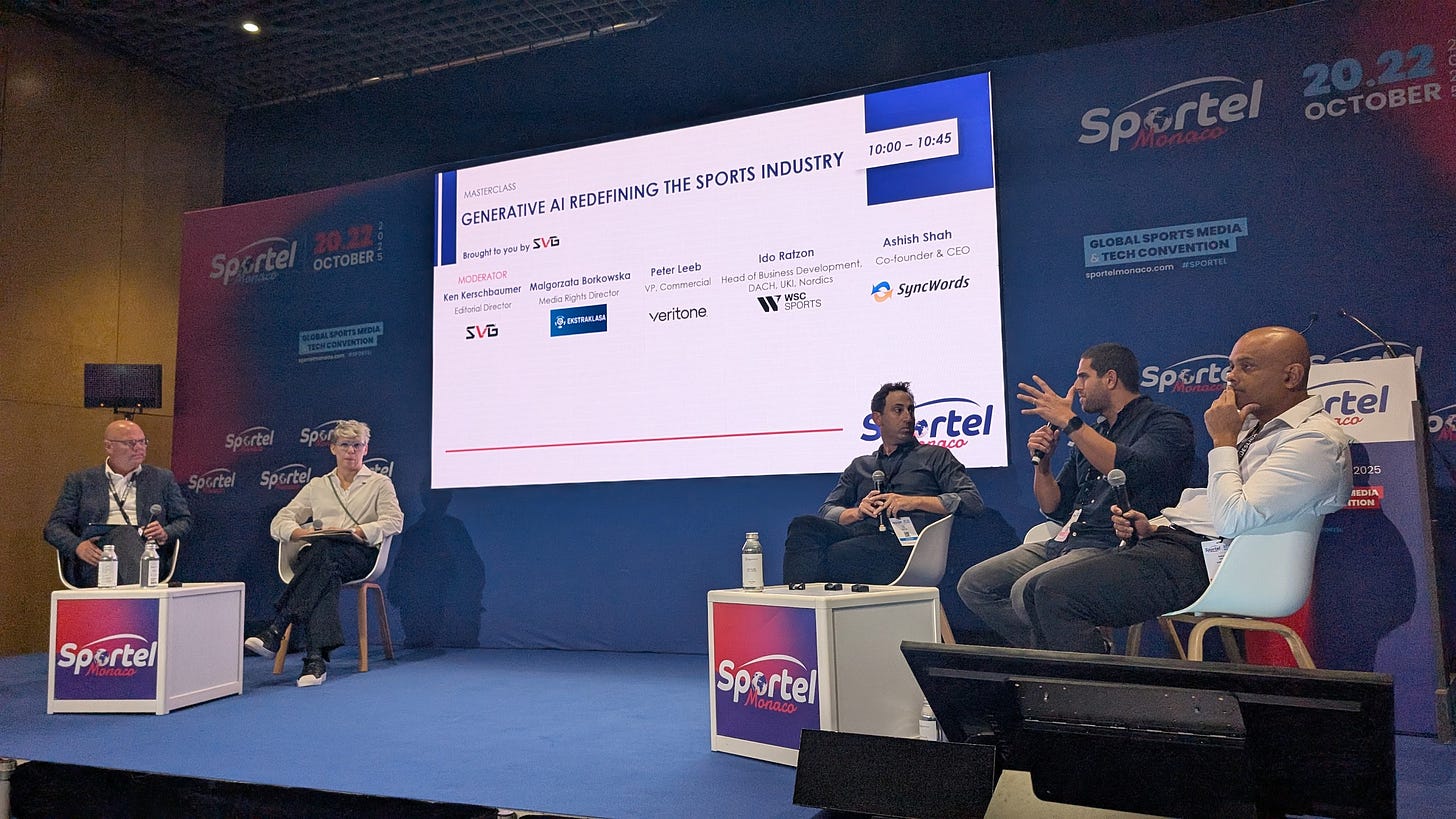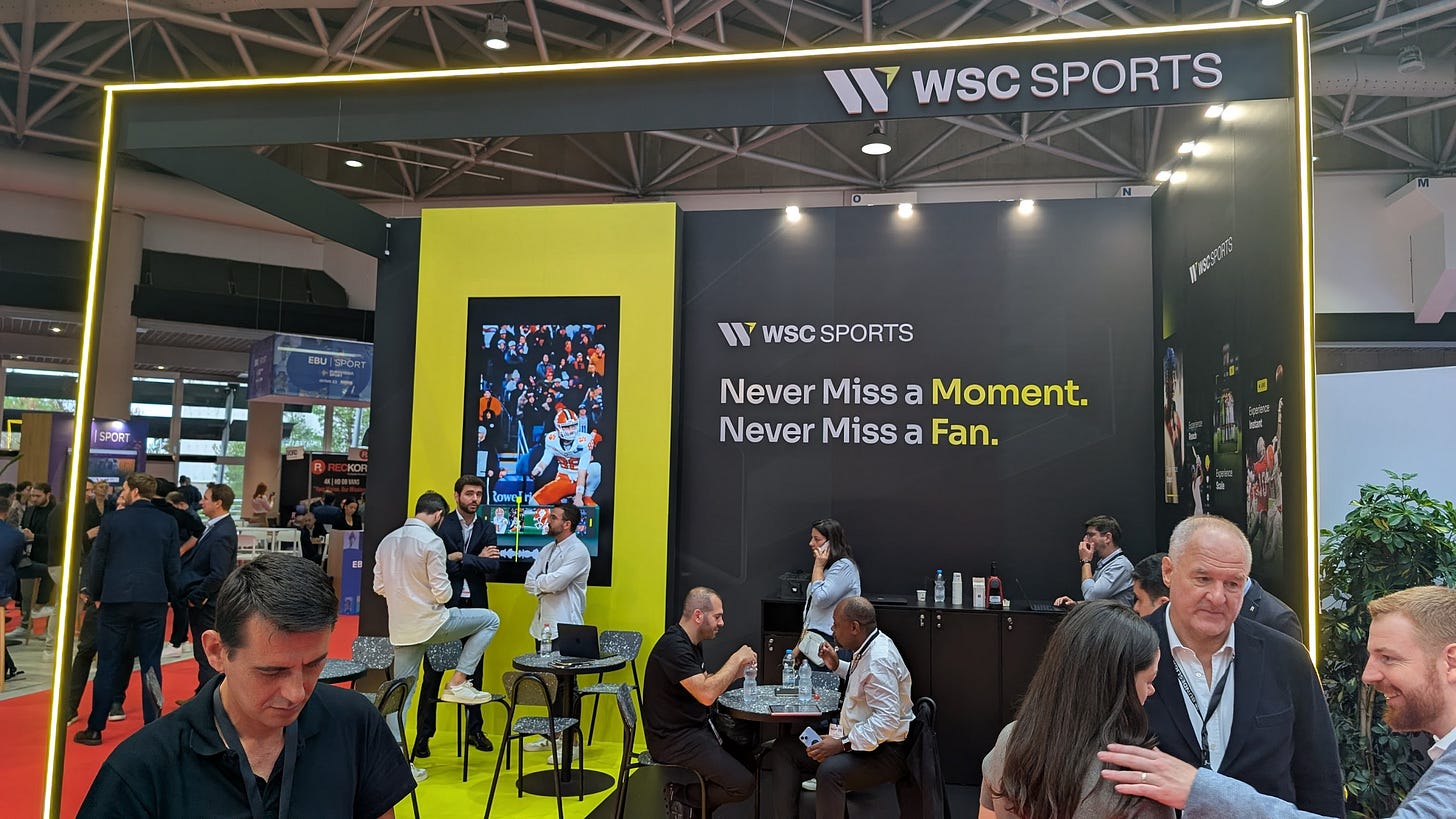⚽️ How Sports Tech Connects Fans in MENA
“The challenge isn’t creating more content, it’s creating connected content.” Ross Munro, WSC Sports
Hey streamers! Today, let’s talk about sports tech ⚽️👇
I love watching sports on streaming services. But like many of you, I don’t always have time.
Time to follow different leagues. Time to watch full football matches or long tennis finals.
That’s why I’m watching more highlights!
Highlights of my team Olympique de Marseille. The best points from the US Open final between Carlos Alcaraz and Jannik Sinner. Or the top actions from Victor Wembanyama with the Spurs.
One company creates many of these automated highlights. WSC Sports. They build the in-app stories and vertical video tools used by major sports leagues around the world.
And today, they do even more. They help teams, leagues and broadcasters create, share and personalise content so they can connect better with their fans.
I met Ross Munro during his visit to Dubai last week. He explained why WSC Sports was at SPORTEL Monaco and shared how the company can support the MENA region.
Here’s our full chat 👇
What brought the WSC Sports team to SPORTEL Monaco this year?
“SPORTEL Monaco is one of those events where you can feel the pulse of the global sports media industry, and this year the conversations were about scale and sophistication.
For WSC, the goal was to show how our platform has evolved far beyond automated highlights. Today, we’re the connective tissue between the live game and the fan experience, bringing together content creation, distribution, and personalization in a single ecosystem.
We came to discuss a bigger idea: how rights holders can move from managing content operations to truly owning their fan relationships. That’s where the next wave of growth is happening, especially in emerging digital markets like MENA, where audiences are young, connected, and ready to engage directly with their favorite leagues and teams.“
“Today, WSC Sports is the connective tissue between the live game and the fan experience, bringing together content creation, distribution, and personalization in a single ecosystem”
Looking back at the event, what themes seemed to dominate this year?
“The dominant theme was AI maturity. A couple of years ago, AI was seen as an experiment, something you might pilot to clip faster or automate a few workflows. This year, it’s about execution at scale:
How do we connect AI to monetization? How can we use automation to personalize experiences, not just speed up production?
Another strong theme was data ownership, how to use fan engagement signals from digital touchpoints to strengthen direct relationships. Every rights holder knows they can’t depend only on third-party platforms forever. They’re looking to build owned ecosystems where fan data, content, and monetization flow together seamlessly.
That’s exactly the infrastructure WSC has been building for years.“
Was there anything that surprised the team at SPORTEL?
“Yes, what surprised us most was the urgency. Everyone is moving fast toward the same realization: the value isn’t just in creating content, it’s in connecting it across platforms and fan journeys.
At SPORTEL this year, we saw broadcasters and leagues discussing how to capture behavioral data from every fan interaction and use it to personalize content. That’s a major shift. It’s no longer just about being first to post a highlight, it’s about building sustained, owned engagement across digital ecosystems.
That trend is especially relevant for MENA, where OTT adoption is accelerating and fans are consuming content mainly through mobile. The infrastructure is ready, now it’s about making those digital experiences more intelligent, connected, and personal.“
“By 2030, I believe every fan touchpoint, whether it’s a highlight, notification, or story, will be personalized by default”
Your recent In-App Stories & Moments report showed major shifts in fan behavior. How fans are changing, and what it means for broadcasters in regions like MENA?
“The clearest signal is that the fan journey now starts vertically on mobile. Across the WSC platform, average video length dropped by 24% since 2020, and vertical formats now make up the majority of all videos created.
Fans are consuming faster, more personalized, and more platform-specific content than ever.
In the MENA region, that trend is even stronger. You have one of the youngest sports audiences globally, and they’re overwhelmingly mobile-first. They expect sports content to look and feel like the social platforms they live on, personalized, quick, and interactive.
Our In-App Stories solution was built exactly for that. It helps rights holders turn their own apps into engaging, story-like environments where fans can consume, swipe, and interact, while staying inside an owned platform. For broadcasters and streamers in MENA, that’s the bridge between engagement and monetization.“
What’s one challenge in sports media that you think people still underestimate, especially in fast-growing markets like MENA?
“The challenge isn’t creating more content, it’s creating connected content. Too many organizations still treat production, distribution, and fan data as separate workflows. The result is inefficiency: great content that doesn’t always reach the right audience, at the right time or in the right format.
In reality, the future belongs to organizations that connect the entire ecosystem, where content creation is linked directly to distribution rules, fan insights, and monetization outcomes.
That’s what our partners like LaLiga and Ligue 1 have already achieved, they’re not just producing highlights; they’re running their entire fan engagement engine through the WSC platform.
For MENA rights holders, this means starting from a cleaner slate, they can build those integrated, data-led systems now, without inheriting years of legacy complexity.“
“In the MENA region, you have one of the youngest sports audiences globally, and they’re overwhelmingly mobile-first”
What’s one thing WSC Sports is doing differently today that others in the industry could learn from?
“We focus on outcomes, not output. It’s not just about how many videos you produce, it’s about what that content achieves, engagement, dwell time, revenue or fan acquisition.
Our platform connects the entire journey from ingestion to insight, from capturing a live moment to measuring its performance across channels. That’s why FZ Sports grew digital revenue 6× in one year using our platform, producing over 50 videos per match and driving an eightfold increase in views.
These are examples of a new kind of efficiency, not just faster creation, but smarter performance.“
Fast-forward to 2030, what kind of impact do you hope WSC Sports will have on how fans experience sports?
“By 2030, I believe every fan touchpoint, whether it’s a highlight, notification, or story, will be personalized by default. Fans won’t just receive the same content feed, they’ll see stories shaped by their favorite teams, players, and behaviors, in their preferred language and format.
Our vision is that WSC Sports becomes the invisible infrastructure behind that experience, powering the content, data, and distribution layers that make personalization seamless.
This means that when a fan in Cairo, Madrid or Manila opens an app, they’ll each see something different, but all powered by the same AI and automation backbone. That’s what fan experience at scale truly means.“
“The challenge isn’t creating more content, it’s creating connected content”
What’s the biggest opportunity right now for MENA broadcasters, streamers, and rights holders when it comes to digital sports content?
“The biggest opportunity is to leapfrog legacy workflows. MENA’s sports and streaming ecosystem is young, ambitious, and incredibly connected. You don’t need to retrofit decades of broadcast infrastructure, you can build directly for the digital fan economy.
That means using AI and automation to deliver content in real time, in Arabic and other local languages, tailored to the platforms fans already use. It’s a space where innovation can move faster because audiences are open to new formats and experiences.
We’ve already seen how localization drives results, like the NBA’s GenAI voice-over partnership with WSC, which achieved a 75% completion rate on two-minute localized highlights across multiple languages.
For MENA broadcasters and streamers, the playbook is simple: automate the production, personalize the experience, and own the fan relationship.“
How do you see AI changing the balance between global reach and local identity, especially for Arabic-speaking audiences?
“AI is breaking the old trade-off between global scale and local relevance. In the past, content had to choose, reach everyone or resonate deeply with someone. Now you can do both.
The same goal can be narrated, localized, and styled differently for each market, instantly. For Arabic-speaking audiences, that’s a massive opportunity to blend global moments with cultural nuance and local storytelling.
We see this already with rights holders that use AI to deliver highlights and stories in multiple languages within minutes of a live event. That’s not just innovation, it’s inclusion at scale.“
Thanks for reading us, See you online this Friday for a new edition of my Streaming in Short!
🧪 Fresh from The Lab:
Not a member yet? Join The Lab 🧪 and unlock the full experience. Here’s what you get as a premium member:
✅ Streaming in Short – Weekly news updates on MENA and global streaming
✅ MENA Insights – Analysis of key streaming trends in MENA, backed by data
✅ Inside The LAB Podcast Series – Real talk from the people driving the streaming media business.
✅ Event Wrap-ups – Smart AI summaries of industry panels and talks
✅ Full Library Access – Read all free and premium articles
✅ Special Reports – Exclusive insights from local MENA platforms (The Secret Lab access)









